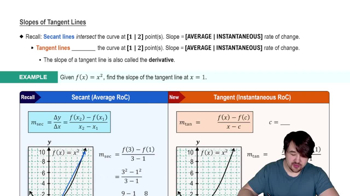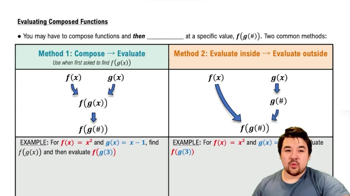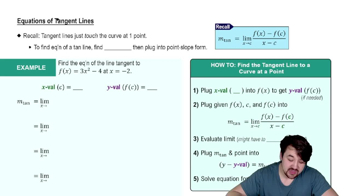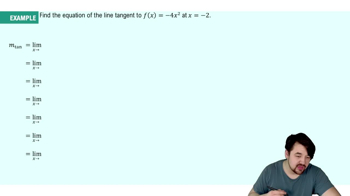Table of contents
- 0. Functions7h 52m
- Introduction to Functions16m
- Piecewise Functions10m
- Properties of Functions9m
- Common Functions1h 8m
- Transformations5m
- Combining Functions27m
- Exponent rules32m
- Exponential Functions28m
- Logarithmic Functions24m
- Properties of Logarithms34m
- Exponential & Logarithmic Equations35m
- Introduction to Trigonometric Functions38m
- Graphs of Trigonometric Functions44m
- Trigonometric Identities47m
- Inverse Trigonometric Functions48m
- 1. Limits and Continuity2h 2m
- 2. Intro to Derivatives1h 33m
- 3. Techniques of Differentiation3h 18m
- 4. Applications of Derivatives2h 38m
- 5. Graphical Applications of Derivatives6h 2m
- 6. Derivatives of Inverse, Exponential, & Logarithmic Functions2h 37m
- 7. Antiderivatives & Indefinite Integrals1h 26m
- 8. Definite Integrals4h 44m
- 9. Graphical Applications of Integrals2h 27m
- 10. Physics Applications of Integrals 2h 22m
2. Intro to Derivatives
Tangent Lines and Derivatives
Problem 42a
Textbook Question
Derivatives and tangent lines
a. For the following functions and values of a, find f′(a).
f(x) = 1/3x-1; a= 2
 Verified step by step guidance
Verified step by step guidance1
Step 1: Identify the function f(x) = \frac{1}{3}x - 1 and the point a = 2 where you need to find the derivative f'(a).
Step 2: Recall that the derivative f'(x) of a linear function f(x) = mx + b is simply the coefficient m of x. In this case, f(x) = \frac{1}{3}x - 1, so the derivative f'(x) is \frac{1}{3}.
Step 3: Since the derivative of a linear function is constant, f'(x) = \frac{1}{3} for all x. Therefore, f'(a) = f'(2) = \frac{1}{3}.
Step 4: Interpret the result: The derivative f'(a) = \frac{1}{3} represents the slope of the tangent line to the graph of f(x) at the point where x = 2.
Step 5: Conclude that the slope of the tangent line at x = 2 is \frac{1}{3}, which means the line rises \frac{1}{3} unit for every 1 unit it moves to the right.
 Verified video answer for a similar problem:
Verified video answer for a similar problem:This video solution was recommended by our tutors as helpful for the problem above
Video duration:
4mPlay a video:
Was this helpful?
Key Concepts
Here are the essential concepts you must grasp in order to answer the question correctly.
Derivatives
A derivative represents the rate of change of a function with respect to its variable. It is defined as the limit of the average rate of change of the function as the interval approaches zero. In practical terms, the derivative at a point gives the slope of the tangent line to the function at that point.
Recommended video:

Derivatives
Tangent Lines
A tangent line to a curve at a given point is a straight line that touches the curve at that point without crossing it. The slope of the tangent line is equal to the derivative of the function at that point. This concept is crucial for understanding how functions behave locally around specific values.
Recommended video:

Slopes of Tangent Lines
Function Evaluation
Function evaluation involves substituting a specific value into a function to determine its output. In the context of derivatives, evaluating the function at a point 'a' allows us to find the slope of the tangent line at that point, which is essential for understanding the function's behavior at that specific location.
Recommended video:

Evaluating Composed Functions

 5:13m
5:13mWatch next
Master Slopes of Tangent Lines with a bite sized video explanation from Nick
Start learningRelated Videos
Related Practice



